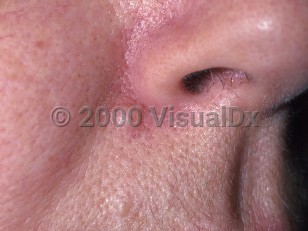Common acquired nevus in Child
See also in: External and Internal Eye,Hair and Scalp,Oral Mucosal LesionAlerts and Notices
Important News & Links
Synopsis

Common acquired nevi (moles) include junctional, dermal, and compound nevi, which are all considered benign. These distinctions are based upon the location of melanocytic nests in the epidermis, dermis, or both, respectively. Clinically, junctional nevi are flat (macular) whereas dermal and compound nevi are elevated relative to the surrounding skin (papular).
Nevi typically arise during childhood, adolescence, or very early adulthood and then senesce in later years. Compound nevi are more common in individuals with lighter skin phototypes; other forms of nevi (those on palms, soles, conjunctiva, and in the nail bed) are more common in individuals of African and Asian descent.
Nevi typically arise during childhood, adolescence, or very early adulthood and then senesce in later years. Compound nevi are more common in individuals with lighter skin phototypes; other forms of nevi (those on palms, soles, conjunctiva, and in the nail bed) are more common in individuals of African and Asian descent.
Codes
ICD10CM:
D22.9 – Melanocytic nevi, unspecified
SNOMEDCT:
400096001 – Melanocytic nevus
D22.9 – Melanocytic nevi, unspecified
SNOMEDCT:
400096001 – Melanocytic nevus
Look For
Subscription Required
Diagnostic Pearls
Subscription Required
Differential Diagnosis & Pitfalls

To perform a comparison, select diagnoses from the classic differential
Subscription Required
Best Tests
Subscription Required
Management Pearls
Subscription Required
Therapy
Subscription Required
References
Subscription Required
Last Updated:07/04/2016
 Patient Information for Common acquired nevus in Child
Patient Information for Common acquired nevus in Child
Premium Feature
VisualDx Patient Handouts
Available in the Elite package
- Improve treatment compliance
- Reduce after-hours questions
- Increase patient engagement and satisfaction
- Written in clear, easy-to-understand language. No confusing jargon.
- Available in English and Spanish
- Print out or email directly to your patient
Upgrade Today

Common acquired nevus in Child
See also in: External and Internal Eye,Hair and Scalp,Oral Mucosal Lesion

